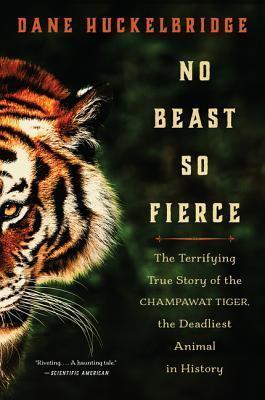
I love tigers. I think they are among one of the most majestic beasts on this planet, and it tears me apart that people continue to hunt them to the point of extinction. Between the cover and the title, there was no doubt I was going to pass on the opportunity to read about the Champawat tiger to find out what made her so deadly. Dane Huckelbridge and No Beast So Fierce does not disappoint.
You would think that a story about man-eating tigers would change my mind about these fearsome beasts. Instead, I have even more compassion for these misunderstood animals. I say misunderstood because I feel that people view tigers or any animals that eat humans as vicious and vengeful. Mr. Huckelbridge shows, however, that in the case of man-eating tigers in India at least, the reasons why animals become man-eaters are often, if not entirely, the fault of humans. We are the ones encroaching on their territory. We are the ones changing their natural habitat. Because of our actions, we are the ones forcing them to compete with each other for a dwindling supply of food. With competition comes injury. With injury comes desperation. A desperate animal will do anything to survive, even if it means roaming far from home to find a more accessible, more attainable food source.
The fact that I feel for these animals and the hardships humans have wrought on them does not mean I ever want to meet one in the open. Mr. Huckelbridge does not ignore any of a tiger’s weapons and makes sure readers understand how they hunt and how they kill. The pictures he paints and the facts he records are gruesome. They make a horror film seem tame by comparison. For all the gore though, Mr. Huckelbridge maintains his sense of reverence for these animals, no matter how many humans one killed, because he understands, and he makes sure readers understand, that for an injured, starving animal, discovering how easy it is to hunt these odd, two-legged animals is the animal equivalent of humans inventing the wheel. If humans can and do resort to cannibalism in times of starvation, there should be no surprise when an equally hungry tiger will look at humans as nothing more than easy prey.
The story Mr. Huckelbridge tells is not just one of a tiger adapting its hunting to eat humans. It is also a story of the geopolitical conflicts arising during the Victorian era in northern India. It is another story highlighting the arrogance of the British colonials and the negative impact British occupation had on all aspects of native life, including but not limited to weapon ownership, hunting, agriculture, cultural rites, and respect for nature. Mr. Huckelbridge navigates readers through the sociological, economic, and political conflicts occurring before, during, and after the Champawat tiger’s reign of terror to help us understand how such a thing could happen and why it keeps happening.
What No Beast So Fierce becomes is a conservation novel in the guise of a historical horror novel. In understanding the hows and whys of tigers becoming man-eaters, it allows readers to know how we can save these beasts and the reasons why we should. The knowledge does not remove the numerous weapons available to tigers while hunting, but it does make them a bit less terrifying. If knowledge is power, then Mr. Huckelbridge and No Beast So Fierce is a powerful weapon in the fight against extinction.
